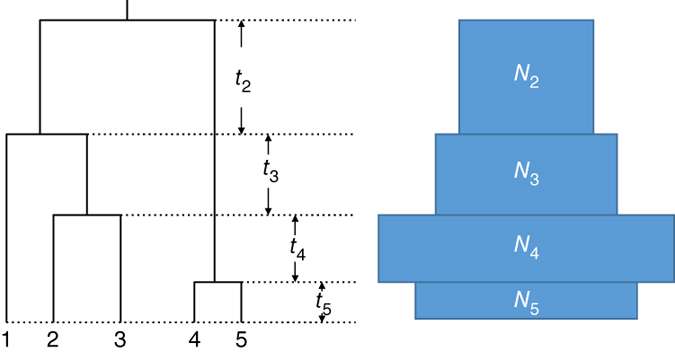April 7, 2015 report
Researchers take new approach to determine historical population fluctuations

(Phys.org)—A pair of researches with the University of Texas has used a new method to infer historical human population size fluctuations based on Single Nucleotide Polymorphism (SNP) data. In their paper published in the journal Nature Genetics, the team describes how they applied a technique they call a stairway plot to SNP data to uncover human population fluctuations going back hundreds of thousands of years.
SNP is a DNA sequence variation that occurs commonly among a given population. Scientists have been using information read from it to trace lineage and to follow population fluctuations over time. In this new effort, the researchers used a different math technique on DNA data obtained from nine populations included in the 1000 Genome Project. Rather than using techniques that rely on predefined population models, the pair of researchers instead came up with a model-flexible method that allows for using SNP spectra data to estimate population size during different periods in history.
Using their technique, the researchers were able to show population bottlenecks (sudden sharp reductions in population size) going back 200,000 years. They found, for example, that there was a population bottleneck in Europe approximately 20 to 30,000 years ago (though it did not include people living in Finland). They also found a bottleneck in Africa occurred 100 to 200,000 years ago in Africa.
The two researchers describe their method as a multi-epoch model that is similar to a skyline plot in that it can be used to calculate the likelihood of a given frequency spectrum—and it allows for treating each DNA sequence as an independent locus, which they noted reduces computational load and makes it possible to study hundreds of individuals, which of course makes historical population estimating much more accurate.
For each of the nine populations studied, the duo created 200 frequency spectra which led to a stairway plot based on median population size for a given period in history. They report that their technique revealed that all of the populations that were not Africa based experienced severe drops in population between 50 and 70,000 years ago. The population in Finland stood as a different however, in that they had a separate drop between 10 and 20,000 years ago, as opposed to the rest of Europe which saw its major drop approximately ten thousand years later. The researchers suggest this was due to early Finnish people separating themselves from the rest of Europe. They note also a sharp African population drop approximately 50 to 70,000 years ago, and then again 20 to 30,000 years ago.
More information: Exploring population size changes using SNP frequency spectra, Nature Genetics (2015) DOI: 10.1038/ng.3254
Abstract
Inferring demographic history is an important task in population genetics. Many existing inference methods are based on predefined simplified population models, which are more suitable for hypothesis testing than exploratory analysis. We developed a novel model-flexible method called stairway plot, which infers changes in population size over time using SNP frequency spectra. This method is applicable for whole-genome sequences of hundreds of individuals. Using extensive simulation, we demonstrate the usefulness of the method for inferring demographic history, especially recent changes in population size. We apply the method to the whole-genome sequence data of 9 populations from the 1000 Genomes Project and show a pattern of fluctuations in human populations from 10,000 to 200,000 years ago.
Journal information: Nature Genetics
© 2015 Phys.org


















